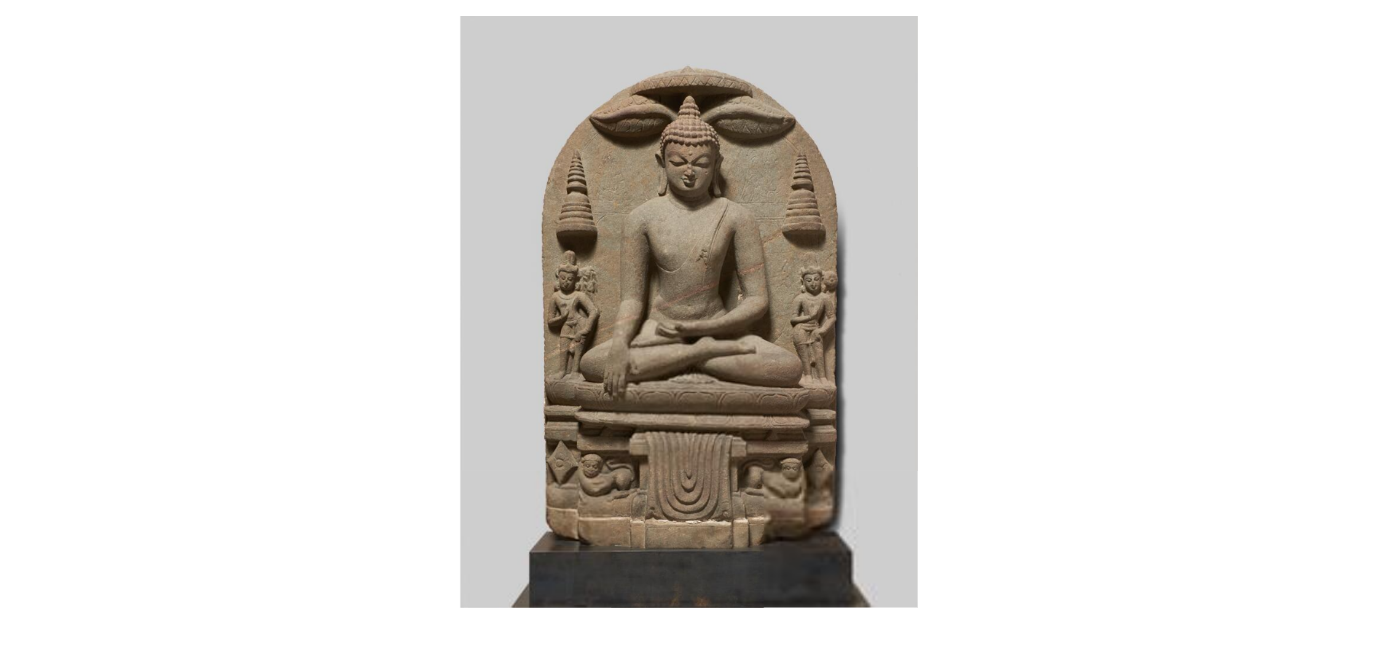Introduction
The Buddhist Triad featuring Maitreya, Shakyamuni, and Avalokiteshvara at the Norton Simon Museum in Pasadena, California, is analyzed. The 1000 CE Bihar, Gaya (?) artwork creates a peaceful and meditative environment that draws the visitor into Buddhism and its profound meaning. When entering the museum, the object’s simplicity and the quiet surroundings created a peaceful atmosphere. This sculpture of Buddha Shakyamuni’s enlightenment conveys peace and importance via its content, composition, and materials, allowing visitors to experience Buddhism.
Physical Condition and Material

Due to its resemblance to sandstone, schist is ideal for this sculpture. The naturalness of the material and its corresponds to the Buddhist values of minimalism and love of nature. Careful inspection reveals degradation and accidental damage. The Buddhist figure’s stomach has a crimson stripe, suggesting abrasion or damage. Despite these shortcomings, the content keeps its core. It is important to acknowledge that this sculpture constitutes a comprehensive entity rather than a partial piece, affording spectators the chance to appreciate the totality of its composition fully. This aspect serves to augment the overall influence and perception of the artwork.
Content
The central focus of this sculpture is Buddha Shakyamuni, who is represented seated beneath a tree that, as the surrounding branches show, is strongly similar to the bodhi tree. This sitting posture represents the moment of enlightenment, an important and beloved event within the vast tapestry of Buddhists.
Composition
The arrangement of forms in the sculpture is meticulously composed to convey the significance of the moment. Buddha Shakyamuni is the largest figure, centrally positioned, emphasizing his role as the central figure. The two flanking figures, Maitreya and Avalokiteshvara, contribute to the overall composition, creating a sense of balance and unity. The presence of bodhi tree branches framing the Buddha’s head reinforces the symbolism of enlightenment, thereby enhancing the composition. The design effectively conveys the gravity of the scene.
Color
The sculpture, made of schist, resembles the color of sandstone commonly used in garden sculptures. This creates a natural and serene ambiance that reflects Buddhist principles of simplicity and harmony with nature. The color scheme of the sculpture precisely reflects the organic hues of the natural world, reinforcing its authenticity and strong connection to its subject matter. The color matching of the material enhances the spirituality and authenticity of the artwork, allowing viewers to see their deep connection.
Tradition, Motifs, and Period Style
This sculpture dates back to approximately 1000 AD and is believed to have originated in Bihar, Gaya, India. The artist’s identity is unknown. The artwork focuses on the central themes of Buddha Shakyamuni, Maitreya, and Avalokiteshvara. The motifs in this piece strongly connect it to the Buddhist tradition of its time, effectively expressing the core beliefs and visual elements of Buddhism. The sculpture reflects the prevailing artistic style of its time by following the established artistic conventions and motifs of that period.
Function
This sculpture functioned as a religious artifact primarily created for the purposes of reflection and devotion. Originally, it would have been located in a Buddhist setting, possibly in a monastery or temple. The purpose of the portrayal was to depict the significant moment of Buddha Shakyamuni’s enlightenment visually. This representation sought to inspire devotion and encourage reflection for those who had the privilege of encountering it in its designated location.
Space
The sculpture possesses a tangible sense of volume, occupying a three-dimensional space. The main volumes include representations of Buddha Shakyamuni, Maitreya, and Avalokiteshvara. To fully understand the complexities of the artwork, observers tend to position themselves at a moderate distance naturally. The chosen distance is important for fully appreciating the composition without becoming overwhelmed. The artist skillfully manipulates the curves and angles in this relief sculpture, effectively conveying depth and dimension. This enhances the viewer’s engagement with the artwork.
Lines and Light
This sculpture utilizes a blend of open and closed forms. The Buddha figure appears more compact and solid, while the bodhi tree branches create a feeling of expansiveness. The artwork’s lines are meticulously drawn, highlighting the tranquil expression on Buddha Shakyamuni’s face. Light is crucial for enhancing the texture and contours of a sculpture, as it creates highlights and shadows that emphasize its three-dimensional form and depth.
Technique
The sculptor has remarkable proficiency in manipulating the schist medium, exemplifying a painstaking focus on intricacy and accuracy. The artist’s significant experience and artistry are evident in the execution of lines, textures, and overall composition. The sculpture incorporates several portions that utilize diverse techniques, each strategically employed to generate certain effects. This collective approach serves to enhance the overall quality and expressiveness of the artwork, showcasing its mastery.
Conclusion
The Buddhist Triad with Maitreya, Shakyamuni, and Avalokiteshvara is a captivating work of art that invites viewers to contemplate a significant moment in Buddhist history. Through careful analysis of its content, composition, color, tradition, function, and technique, we gain insight into the object’s purpose and the skill of the artist. The sculpture’s simplicity, combined with its intricate details, provides a profound visual experience that transcends time and culture, making it a valuable piece for both art enthusiasts and those interested in the spiritual and historical aspects of Buddhi.
Bibliography
Bellini, Chiara , and Louise Tythacott. “Kagbeni Monastery Shrine Display.” SOAS University of Londod, 2019. Web.
Boucher, Brian. “Buddhist Art: These Ancient Images Are More Timely than You Think.” CNN, 2020. Web.
Brooklyn Museum. “Buddha Meditating under the Bodhi Tree.” Brooklyn Museum, 2023. Web.
Huang, Bing. “The Posture of Lalitāsana: Buddhist Posing Hierarchy in a Tang-Dynasty Chinese Bronze Sculpture.” Religions 13, no. 8 (2022): 740. Web.
Mat, Mahmut. “Schist: Properties, Formation, Occurrence and Uses.” Geology Science, 2023. Web.
Norton Simon Museum. “About the Collection.” The Norton Simon Foundation, 2023. Web.
Tythacott, Louise, and Chiara Bellini. “Deity and Display: Meanings, Transformations, and Exhibitions of Tibetan Buddhist Objects.” Religions 11, no. 3 (2020): 106. Web.